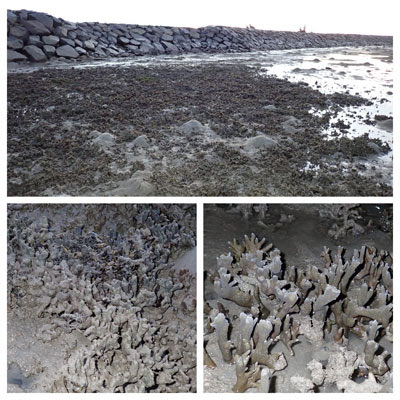Today, we estimate less bleaching - 10% of hard corals, few leathery soft coral. But we estimate about 60% of hard corals are dead and there seems to be fewer and smaller leathery small colonies. However, the shore remains very much alive and the team spot special animals.
As usual, the rest team make all the special finds. The Yellow-lipped sea krait is seen again! At the jetty, the Cave corals were still in full bloom, made extra special with a Mosaic crab. There were Arabian cowries, and juvenile bat fish.
 |
| Photos by Tommy Tan. Link to his album below. |
Kelvin checked out the shore under the jetty and saw Cone snail and a Masked burrowing crab! The rest of the team also saw other colourful marine life including 'Nemo'. Everyone saw the Yellow lipped sea krait, except me.
The reef edge outside the Northern lagoon is densely covered in hard corals. In Jun 2024, most corals were alright, with about 20% outright bleaching, and an additional 5% showing stress - pale or pinkish. Today, the tide wasn't as low so I couldn't see much of the reef edge. Of those I saw, about 10% were bleaching, and about 60% of hard corals were dead or had large dead portions. But there were still a few that were alright, including large colonies and some less commonly seen corals.
Corals have settled inside the Northern lagoon. The large patch of Branching montipora corals is mostly dead, but on the outer edge of the patch, about 10% of these corals were alive and not bleaching. Hopefully, these will recover soon. I sense far fewer corals here, and the area near the seawall opening was much sandier and bare. |
| Collage of photos by the team. Links to albums below. |
In Jun 2024, there were many large Leathery soft corals colonies and about 40% were bleaching or showing signs of severe stress - very pale or yellowish. Today, although few were bleaching and most were normal coloured, I sense fewer and smaller colonies. Especially those near the seawall which were melting or fragmented.
Other cnidarians can also bleach, so I looked out for those too. Today, there seemed to be even more Magnificent anemones in more places than in the past. They seemed smaller than usual, but none bleaching. One even had an anemonefish! I saw one Giant carpet anemone. I saw a few large Sea mat zoanthids and most were bleaching. The rest of the team also saw a Fire anemone.
The NOAA prediction for the Singapore Strait seems to suggest that sea temperatures will ease in the weeks ahead. Let's hope we have indeed passed the peak of mass coral bleaching and that our reefs will start to recover.Fortunately, I didn't see large obvious signs of impact from the 400tonne Pasir Panjang oil spill on 14 Jun 2024, about two months ago.
What is the future of Kusu Island?
The rich reefs of Kusu Island of today are slivers of massive reef flats that were reclaimed less than one human lifetime, 50 years ago. Today, all these vast reef flats have been reclaimed, leaving very narrow margins outside the seawall that can only be accessed by non-divers at the very lowest tides. Check out the Historical maps of Singapore by NUS Libraries site where you can actually overlay the various maps over time and use a slider to see the changes.
Kusu Island was in fact originally a tiny outcrop where the temple now is. And during the annual Kusu Island pilgrimage, devotees would land by sampan. As captured by this iconic photo by Ivan Polunin, from "Once upon an island: A rare peek into our past" Scenes of old Singapore through the lens of the late naturalist Ivan Polunin. Wallace Woon, Straits Times 20 Sep 2023.
Recently, it was announced that the reefs outside the northern lagoon of Kusu Island would be part of Singapore's second national Marine Park at Lazarus South-Kusu Reef. It is good to cherish and protect what we have left. More on Singapore's second marine park: past, present and future.
In fact, the Singapore Blue Plan 2018 recommended the cluster of Kusu, Lazarus and St. John's Islands for elevated protection status.
The Blue Plan highlights that Lazarus, St. John’s, and Kusu Islands are established sites for coral nurseries as their shoreline offers ideal sheltered areas for growth of corals. Designating these islands as No-fishing Areas can bolster their rehabilitation. Protecting a larger cluster of islands means zonation plans for use can be implemented to manage tourism and human impacts.
DOWNLOAD the Plan, SUPPORT the Plan! More on the Singapore Blue Plan 2018 site.
Photos by others on this survey
Tommy Tan
Kelvin Yong Part 1
Part 2
Marcus Ng







.jpg)

